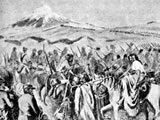What happened that day?
See historic events for any day of the year by entering the date below. Why not try your birthday?
Kiwi of the Week
Today in History

1865 Imperial forces invade South Taranaki
Lieutenant-General Duncan Cameron and 1200 British troops began what was to be the Cameron’s final campaign in New Zealand.
Governor George Grey and the colonial government had been unable to persuade Cameron to mount a further campaign in Waikato. Keen to make use of imperial troops while they still had them, they turned their attention to south Taranaki, a ‘secondary bastion’ of Maori independence.
Grey was unimpressed with what he saw as Cameron’s slow and timid campaign. The Pai Mārire leader Te Ua Haumēne had allegedly called the general ‘The Lame Seagull’, which seemed to confirm Grey’s criticisms. But Cameron’s operations were largely effective. He won substantial victories at Nukumaru on 24–25 January and at Te Ngaio on 13 March. It was his refusal to attack the modern pa of Weraroa that led to the utter collapse of his relationship with Grey. Cameron had learnt from his experiences in Waikato ‘that it is not generally desirable to attack such positions’.
Grey ‘took’ Weraroa himself in July, long after it had lost its strategic significance. Its capture was made easier by the fact that only a small number of Maori defenders remained. Grey was able to further his own reputation at the expense of Cameron. The latter had submitted his resignation early in the campaign and after Grey’s ‘capture’ of Weraroa it was accepted. The general left New Zealand on 1 August.
Image: scene from the Taranaki wars by Major Von Tempsky (NZETC)




















